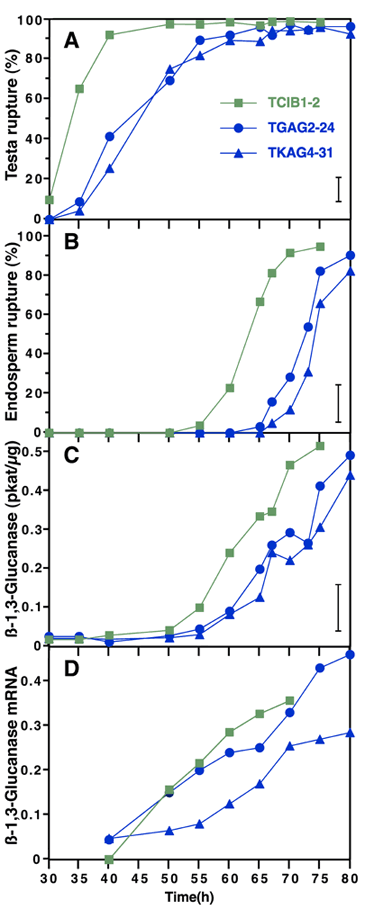Journal of Experimental Botany 52: 1753-1759
(2001)
Antisense-transformation reveals novel roles for class I ß-1,3-glucanase
in tobacco seed after-ripening and photodormancy
 |
Figure 2. The effect of antisense ßGLU I transformation on the time course of ßGLU I induction during germination of afterripened homozygous seed. (A) The incidence of testa rupture expressed as percent scored with time after the start of imbibition in continuous light in control medium. Homozygous, monogenic S2 seed populations of independent ßGLU I-antisense lines TGAG2-24 (ßGLU I promoter) and TKAG4-31 (Cat1 promoter) and of empty-vector line TCIB1-2 were used. (B) The incidence of endosperm rupture. (C) The accumulation of ßGLU enzyme activities expressed in pkat / µg protein. (D) The accumulation of the 1.6 kb ßGLU I mRNA expressed as arbitrary PhosphoImager units per seed. The signals detected and quantified by RNA-blot hybridization using additional seed samples from the experiment described in (A) are corrected for RNA loading based on the 18S ribosomal RNA signals. (A)-(C) Mean values ± SE of two samples each with 100-150 seeds are presented (30 h one sample); SE-values ≤ 2.0 % and ≤ 0.01 pkat / µg protein are not drawn. |
| Article in PDF format (160 KB) | Abstract Fig. 1 Fig. 2 Table 1 Table 2 Glucanase constructs |
http://jxb.oupjournals.org/ |
|
|
The Seed Biology Place |
Webdesign Gerhard Leubner 2000 |